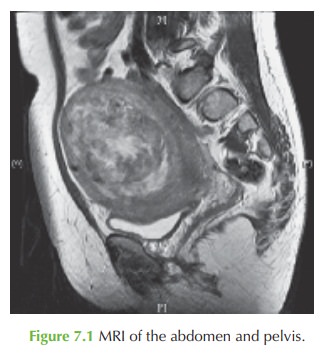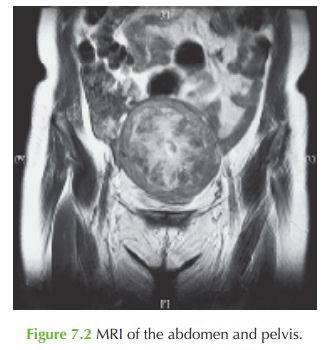Chapter: Case Study in Obstetrics and Gynaecology: General Gynaecology
Case Study Reports: Abdominal Swelling
ABDOMINAL SWELLING
History
A
36-year-old African-Caribbean woman
has noticed abdominal swelling for 10 months. She has to wear larger clothes
and people have asked her if she is pregnant,
which she finds distressing having been trying
to conceive. She
has no abdominal pain and her bowel habit is normal.
She feels nauseated when she eats
large amounts. She
has urinary frequency but no
dysuria or haematuria.
Her
periods are regular, every 27 days,
and have always
been heavy, with
clots and flood- ing on the second
and third days.
She has never
received any treatment for her heavy periods.
She
has been with her partner
for 7 years and despite
not using contraception she has never been pregnant.
Examination
The
woman has a very distended abdomen. A smooth
firm mass is palpable extending from the symphysis pubis
to midway between
the umbilicus and the xiphisternum (equiva- lent to a 32-week size pregnancy). It is non-tender and mobile. It is not fluctuant and it is not
possible to palpate
beneath the mass.
On speculum examination it is not
possible to visualize the cervix. Bimanual
examination reveals a non-tender firm mass occupying the pelvis.



Questions
·
What is the diagnosis?
·
How
would you further
investigate and manage this woman?
Answer
The woman has a large uterine
fibroid (leiomyoma). This is causing menorrhagia and hence the microcytic anaemia
from iron deficiency. It is also likely that the fibroid
is accounting for her infertility history,
although this warrants
investigation as a separate
problem.
Fibroids are benign tumours
of the myometrium which may be extrinsic (subserous) as in this case.
Alternatively they may be intramural or submucosal (projecting into the endo- metrial cavity).

Fibroids are not
typically painful unless
they undergo degeneration, usually in pregnancy.
African-Caribbean women tend to
develop fibroids more commonly than other ethnic groups.
Further investigation
Ferritin and folate levels
should be checked
to confirm the iron-deficiency status.
It is also advisable to arrange
renal function tests
and a renal tract ultrasound, as very large fibroids can cause ureteric
obstruction and hydronephrosis, which would need urgent
treatment.
Management
The
woman should be treated for
her anaemia with
ferrous sulphate. The
menorrhagia can be reduced
with tranexamic acid during menstruation. Gonadotrophin-releasing hormone
analogues temporarily shrink
fibroids and cause
amenorrhoea to allow
correction of iron deficiency. Definitive treatment for fibroids is traditionally by hysterectomy or myomec-
tomy. Myomectomy is favourable for this woman
who is keen to have a family,
so con- servation of the uterus is essential. Uterine artery embolization also causes fibroid degeneration by interruption of the blood
supply. However research
into long-term safety and potential effects on uterine function during pregnancy are
not clear, and
this option is currently
advised in the context of a research
setting only.
Related Topics